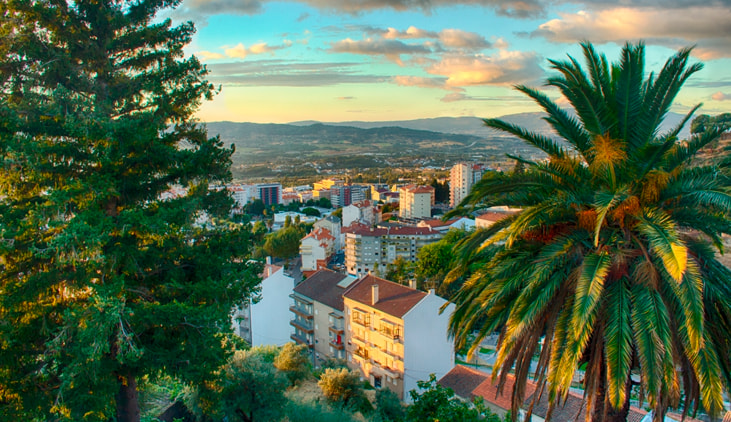Surprise yourself…
At the heart of Covilhã, the central square pays tribute to Pêro da Covilhã, a prominent explorer, diplomat, and spy of the 15th and 16th centuries during the Age of Discoveries. A statue of Pêro stands in front of the Town Hall, beside a large polished granite panel that maps out his travels.
Rebuilt in the second half of the 17th century over an earlier structure from the mid-16th century, the Church of Misericórdia features Mannerist-style architecture. It has a single nave and a narrower, lower chancel, with a bell tower attached to the left side.
A must-see in the city centre is the Municipal Market, housed in an impressive 1940s building. It’s a lively place full of local colour, ideal for discovering regional flavours and crafts.
Este espaço de lazer não só tem uma nova via de acesso pedestre ao centro da cidade, como é possível aceder à zona baixa da Covilhã através da sua ligação urbana entre a Universidade da Beira Interior e o Anfiteatro Mártir-in-Colo. O Parque da Goldra constitui-se como um espaço de lazer ao ar livre, capaz de acolher acontecimentos urbanos, nomeadamente de caráter lúdico e de promoção, bem como o convívio da população.
Suspended more than 200 metres above the Carpinteira stream, this pedestrian bridge connects the city centre to the Penedos Altos neighbourhood. Crossing it is an exciting challenge. At night, it lights up with two long strips of LED illumination.
This centrally located urban park features grassy areas, wooden walkways, a lake bridge, a small amphitheatre, and a great children’s playground. The lighting system is designed to highlight the greenery. A kiosk and a modern outdoor bar add to its charm. The park has recently been renovated to offer even more shaded areas.
The old Jewish Quarter is part of Covilhã’s historical fabric, located right in the city centre. Its narrow lanes and old stone houses tell stories of a vibrant past.
The most iconic and largest church in Covilhã, Santa Maria Maior, was built in the 16th century over the medieval Church of Our Lady of the Castle by order of Bishop Cristóvão de Castro. The building features revivalist and neo-baroque elements, with a single-nave plan and side chapels. Its interior boasts a beautiful rococo main altarpiece.
From this viewpoint, you can appreciate the strategic vantage once held by the nearby castle, which overlooked key access routes and the ancient border with the Kingdom of Castile — a breathtaking panorama still today.
Part of the Polis Programme, this expansive green space offers a restaurant, two bars, a reflecting pool with waterfall, walking paths, recreational boats, a skate park, and a children’s playground. In summer, the area also features a beach-style pool, complete with various leisure activities.
This new recreational space near the Arts Centre stretches over 18,000 m², divided into three terraced levels, each separated by 5-metre-high slopes. A scenic 840-metre walking trail winds through lush green areas. Three metal spiral sculptures visually connect the platforms into a unified artwork, especially striking from the main entrance.
A peaceful green space with flowerbeds, lawns, Portuguese pavement walkways, and garden benches. At its centre stands a statue of Our Lady of the Immaculate Conception.
Located in the city centre, this viewpoint offers a privileged view of Covilhã and the Cova da Beira region. It includes a panoramic café-restaurant, a telescope, and parking for 18 vehicles. Locals affectionately call it the “Minerva Viewpoint”, in memory of the historic Minerva Printing House once located here. Its facilities and location are making it a new landmark of the city.

Located in the lower part of Covilhã, this pool features artificial waves and is equipped with a bar and terrace, changing rooms, outdoor showers, and a sunbathing area. It sits next to one of the city’s largest green areas, Lake Garden, and offers stunning views of Serra da Estrela. With 1,800 m² of water and a capacity for 2,800 people, it also hosts summer events such as fitness sessions and entertainment activities.

Sobral de São Miguel is a charming, centuries-old village nestled in a valley where the Porsim Stream flows. The village is characterised by traditional schist houses with slate roofs. Visitors can explore its narrow streets, stairways, communal ovens, old watermills, wine presses, fountains, bridges, main church, João dos Santos House-Museum, and ancient cork oak trees — all making it well worth a visit.

The history of Drogaria Moderna began with its founder, Acácio Pinto Pereira, who, after 15 years working as a pharmacy assistant, opened his own shop on 15 October 1950. Located on one of Covilhã’s main streets, this family-run store became renowned for its personalised pharmaceutical preparations.
Thanks to Mr. Acácio’s expertise, he created custom-made formulas such as toothpastes, deodorant powders, lotions, creams, perfumes, and healing ointments, which earned the shop a solid reputation for quality and innovation among locals.
